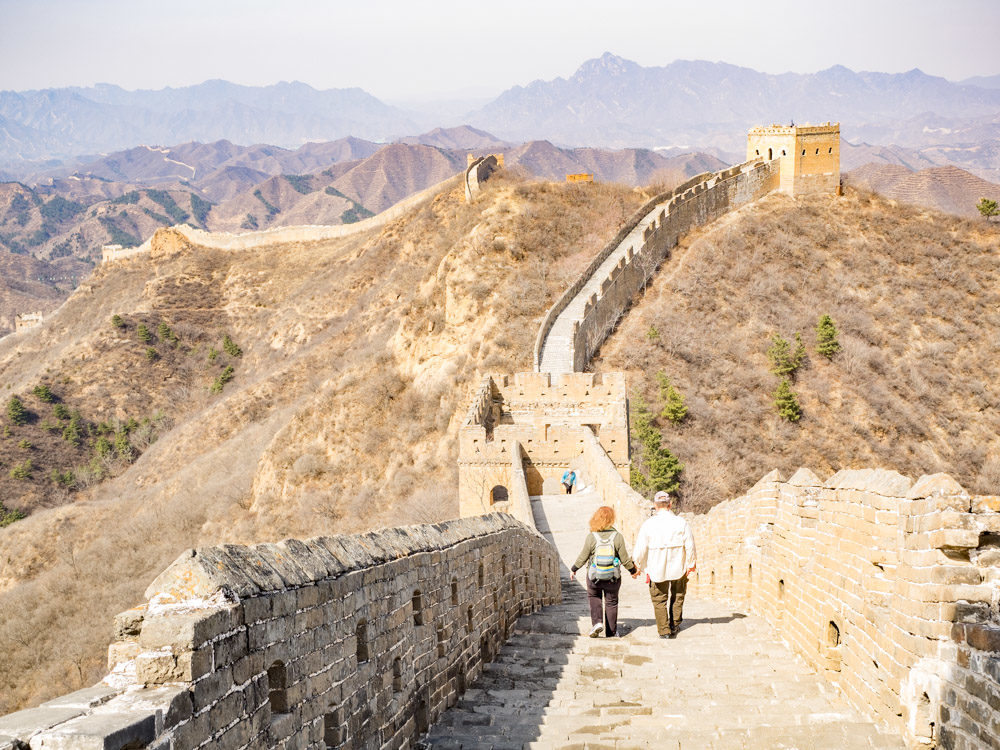The Best Places To See The Great Wall of China From Beijing
***This post may contain affiliate links.***
Beijing is famous as the home of the Great Wall of China. And while this isn’t actually true given the wall is over 3000 kilometers (2000 miles) long and stretches from the ocean in the East to the deserts of Jiayuguan in the West, Beijing is without a doubt the best place to visit China’s iconic Great Wall.
Just outside of Beijing the wall snakes its way over mountain ridge lines and through lush valleys, rolling up and down like the back of a dragon. You can see the wall in either direction as it winds its way through the mountains passing peak after peak traveling on as far as the eye can see.
Why Is Beijing The Best Place To See The Great Wall?
1. Beijing has the most well-maintained sections of wall.
This means you can walk and hike along the wall for hours and never run into trouble or feel unsafe. It also means you can to see the wall as it stood in its glory days and get a glimpse of what it looked like when it was first completed.
2. Beijing is conveniently located with a major international airport and other major tourist attractions in the city.
This makes Beijing incredibly easy to get to both within China and outside of the country. It also means there’s more to do there than just the see the Great Wall, so you’ll be able to make the best use of your limited travel time by seeing many sites in one location.
3. Beijing has the most scenic sections of the Great Wall of China.
The Great Wall outside of Beijing runs along the ridgeline of the Yanshan mountains, which means no matter where you are on the wall you’ll have incredible views.
Read More From Beijing
- The Budget Traveler’s Guide To Beijing
- The Complete Guide To Hiking The Jinshanling Great Wall
- 25 Best Things To Do In & Around Beijing
Best Places To See The Great Wall of China From Beijing
1. Jinshanling

At 130 km away from the city and a 2.5 hour drive, the Jinshanling section is definitely one of the furthest feasible Great Wall sections to visit from Beijing, but the added drive time is absolutely worth it. Not only was the entire section of the wall nothing short of drop dead gorgeous, but I only saw a handful of other tourists the entire time I was there.
The Jinshanling Great Wall was originally built in 1358 and was restored in 1567, but since then the wall has only been maintained, not restored, so it’s about half in good shape, and half crumbling. Because of this when you visit Jinshanling you get a really cool mix of wild and restored wall. It’s the best of both worlds when it comes to scenery.
The Jinshanling Section of the wall stretches for 10.5 kilometers along the rolling ridgeline of the Jinshanling Mountains. Dispersed throughout the wall are a series of 67 watchtowers of varying designs.
To walk the length of the Jinshanling section of the Great Wall takes 4 hours and goes over 5 mountain passes (don’t worry they’re easy enough that anyone in reasonable shape can walk it). The wall runs along the mountain ridge so there’s quite a bit of up and down the entire way, and while there are a few steep sections with stairs, most of the hills here are more gradual.
The climb from the entrance to the wall itself is the most grueling part as you walk straight up the mountain for about 30 minutes, although there is also an option of taking a cable car up to or down from the wall for an additional fee.
I seriously can’t stress enough how stunning the views are at the Jinshanling Great Wall. Hiking along the wall was truly awe-inspiring every step of the way. It’s one of those experiences where you just can’t put the camera down or stop marveling at the world around you. If you’re looking to explore a section of the Great Wall that’s beautiful, has great hiking, and virtually no tourists, then Jinshanling is definitely the place to go.
How to Get To The Jinshanling Great Wall
The easiest and most convenient way to get to the Jinshanling Great Wall is by car. However, hiring a driver is obscenely expensive, especially if you’re a solo traveler. The cheapest I could find a driver for was 900 RMB for the day.
If you’re traveling during peak tourist season from April – October you have the option of taking a bus. There is a direct bus that leaves every morning at 8:30 am from the Wangjing West Bus Station and drops off at the Jinshanling Ticket Gate. The bus leaves from the Jinshanling ticket gate to head back to Beijing at 3:00 pm. Taking the bus will set you back just 32 RMB one way, which is peanuts compared to the cost of a car.
Opening Hours
Peak Season (April – October): 6:00 am – 6:00 pm
Off Season (November – March): 7:00 am – 5:00 pm
Ticket Price
Peak Season: 65 RMB
Off Season: 55 RMB
2. Mutianyu

Mutianyu is definitely one of the easiest and most accessible section of the Great Wall to reach from Beijing – and the best part is that if you get there at the right time, it’s a lot less crowded than some of the others!
Most people visit in either the early morning or late afternoon to avoid the midday sun, but if you can handle the heat, I would definitely recommend aiming to visit around lunchtime! The crowds will be a lot sparser and at times you’ll feel like you have the whole wall to yourself!
You can either choose to take the cable car up the mountain to the wall for around 100 RMB or walk. The walk is tough but not overly so, and you get some fantastic views of the valley below! If you plan on walking, heed my advice and wear sensible shoes – if you wear flip-flops, there’s a very high chance you’ll slip on some loose gravel, twist your knee and be in agony for the rest of the day…
And one thing you can get at Mutianyu that no other sections of the wall offer? A toboggan ride back down the mountain!
How To Get To The Mutianyu Great Wall
To get there from Beijing center you have 2 options: the first, and most simple would be to get a taxi or join an organized tour. Simple, but pricey! The better, more budget-friendly and much more adventurous option is public transport.
You first need to find your way to Dongzhimen Subway Station, then get the 916 Express bus to Huairou North Avenue or Huairou Beidajie. The journey takes around 60 minutes and whatever you do, and however many taxi drivers poke their head onto the bus and insist this is your stop, don’t get off until you see a huge building on the left with “CHINAMOBILE” on top.
From there, get the H23 or H24 from the opposite side of the road to Mutianyu Roundabout and voila, welcome to the Great Wall! The two buses combined come to about ¥15 – try to make sure you have loose change, as the drivers won’t be able to break any big notes.
Opening Hours
8:00 am – 5:00 pm
Ticket Price
45 RMB plus 15 RMB for the shuttle bus to take you to the base of the mountain.
Thanks to Rhiannon Thatcher of Wales To Wherever for contributing her experience of visiting the Mutianyu Great Wall.
3. Jiankou

I managed to not only climb the great wall at Jiankou but camp on it too! Jiankou is an unrestored section of the Great Wall of China, which is only legally accessible by tour. Our tour providers knew the people who owned that section of the wall and part of our tour fee included the owner’s entrance costs. It was well worth the fee – we didn’t see another tourist the entire time!
The hike was about 10 kilometers which included climbing up to the wall and trekking along it. We got some spectacular vistas of not only the typical ‘wall shot’ while climbing along it but a view of the manmade wonder from below. The walk was in some places difficult, with uneven ground and sometimes nothing to hold onto. We camped in a crumbling watchtower and there was even a thunderstorm – adding to the atmosphere.
I’d highly recommend a tour to the Jiankou section of the Great Wall of China. Visiting this section of the wall means you see a part that is completely away from the crowds and that is what made the Great Wall of China so special for me. I almost felt as if I could meet someone from the Ming Dynasty on the next corner…
A Note From Cara: It IS possible to visit Jiankou on your own even though it’s not technically open to the public. All you have to do is pay the local villagers 20 RMB and they will give you access to the wall.
How To Get To The Jiankou Great Wall
If you’re going with a tour, your tour company will provide transportation.
If you want to attempt to hike Jiankou on your own it’s best to hire a driver to take you as there is no direct bus from Beijing to Jiankou.
Opening Hours
As this section is not technically open to the public there are no opening and closing hours. Feel free to visit this section at any time of the day. You can even camp on the wall and spend the night at Jiankou if you want (as mentioned above).
Ticket Price
Again, there’s no set price for visiting Jiankou, but you’ll have to at least pay the local villagers 20 RMB to give you access to the wall and at most pay for a tour guide for the day.
Thanks to Claire of Claire’s Footsteps for contributing her experience of visiting the Jiankou Great Wall.
4. Huanghuacheng

The Huanghuacheng section of the Great Wall is especially unique as it is the only section of the wall built beside a lake or any body of water for that matter. This means when you visit Huanghuacheng you get not only an incredible experience of walking along the longest wall in the world and taking in the incredible mountain scenery, but you can also sit by the beautiful Haoming Lake and enjoy a picnic or a boat ride and get a completely different perspective of the wall.
The Huanghuacheng Great Wall is located 70 kilometers outside of Beijing and can be reached in 1.5 hours by car or 2 hours by bus. This section took over 180 years to complete with construction starting in 1404 and ending in 1592. Due to the construction of a dam at Haoming Lake, part of the original Huanghuacheng Great Wall is now under water.
This section of the wall is completely wild, having never been rebuilt like a lot of the other sections. The mountains around Huanghuacheng are known for their yellow wildflowers which bloom every summer. These flowers actually inspired the name of this section of the Great Wall, as huanghua means yellow flower in Chinese.
Besides beautiful lakeside views and flower-dotted hillsides, another major advantage of Huanghuacheng is that you find hardly any tourists there, even during the peak summer season. This means you can take advantage not just of having the wall to yourself, but also taking a walk or a boat ride around the beautiful Haoming Lake crowd free.
How To Get To The Huanghuacheng Great Wall
Take subway line 2 to Dongzhimen Station. From Dongzhimen take Bus 916 and get off at Huairou Town Station 怀柔汽车站. At Huairou Station take the Huairou Waterside Great Wall Bus 怀柔水长城专线车 (a blue mini bus) to Huanghuacheng. Both bus tickets combined will cost 18 RMB one way. The first bus leaves from Dongzhimen Station at 6:00 am and the last bus returns from Huanghuacheng at 6:00 pm.
Alternatively, of course, you can hire a personal driver for the day to take you to Huanghuacheng completely on your own schedule.
Opening Hours
8:30 am – 5:00 pm
Ticket Price
45 RMB
5. Simatai

To access the wall at Simatai West there are 1,400 steps to climb! It’s hard work, but totally worthwhile for the amazing views of the wall snaking off in either direction. From here, we hiked the wall for several hours.
The unrestored section of the wall at Simatai West was perfect for us, offering a more challenging hike. We loved the crumbling ancient wall at Simatai West, with steep slippery slopes, crumbling steps and steep drops from the wall where the stone railings had fallen away! Don’t be fooled – hiking at Simatai West is very up and down, but great fun.
For adventurous, fun-loving families, this is a great way to see the Great Wall of China. We hired the company Great Wall Hiking for our trip to the wall. They run many tours, particularly to the unrestored sections. They were excellent in every way.
How To Get To The Simatai Great Wall
The easiest and most convenient option for getting to the Simatai section of the Great Wall is to hire a driver for the day. Of course, as usual with hiring private drivers this is also the most expensive option.
Your other option is to take public transportation. Take subway line 2 to Dongzhimen Station. Walk out of the station to Dongzhimen Transit Hub and take Bus 980 to Miyun Bus Station where you will then transfer to either bus Mi 37, Mi 50, or Mi 51, all of which will take you to Simatai Village Station. Get off at Simatai Village Station and walk to the entrance of Gubei Water Town where you can find tickets for the Simatai Great Wall inside of the visitor’s center.
Bus tickets cost 23 RMB one way and the first bus leaves from Dongzhimen Transit Hub at 5:50 and the last bus leaves the wall to return to the city at 3:00 pm.
Opening Hours
Day: 8:00 am – 4:30 pm
Night: 6:00 pm – 10:00 pm
The Simatai Great Wall is one of only two sections that is lit up and open at night, and it’s said to have the best nighttime views.
Ticket Price
40 RMB
Thanks to Nicky of Go Live Young for contributing her experience of visiting the Simatai Great Wall.
No matter what kind of Great Wall experience you’re looking for, there is a crowd-free, incredibly beautiful section of the Great Wall of China waiting for you just outside of Beijing!
WANT TO TRAVEL CHEAPER & EASIER?
Subscribe to follow our blog and be the first to read our new posts!
Success! Happy dance optional :) P.S. check your inbox for goodies!
Like this post? Share the love and pin it on Pinterest!

*** This post may contain affiliate links. By purchasing a product or service through these links you are helping to support this blog at no extra cost to you! We only recommend products we personally use and love! ***





 Hey, we're Cara and Justin, the adventure travel loving couple behind Crawford Creations. We're here to help you travel the world independently, save money on your travels, and discover off the beaten path destinations along the way. Click the About tab to find out more!
Hey, we're Cara and Justin, the adventure travel loving couple behind Crawford Creations. We're here to help you travel the world independently, save money on your travels, and discover off the beaten path destinations along the way. Click the About tab to find out more!


